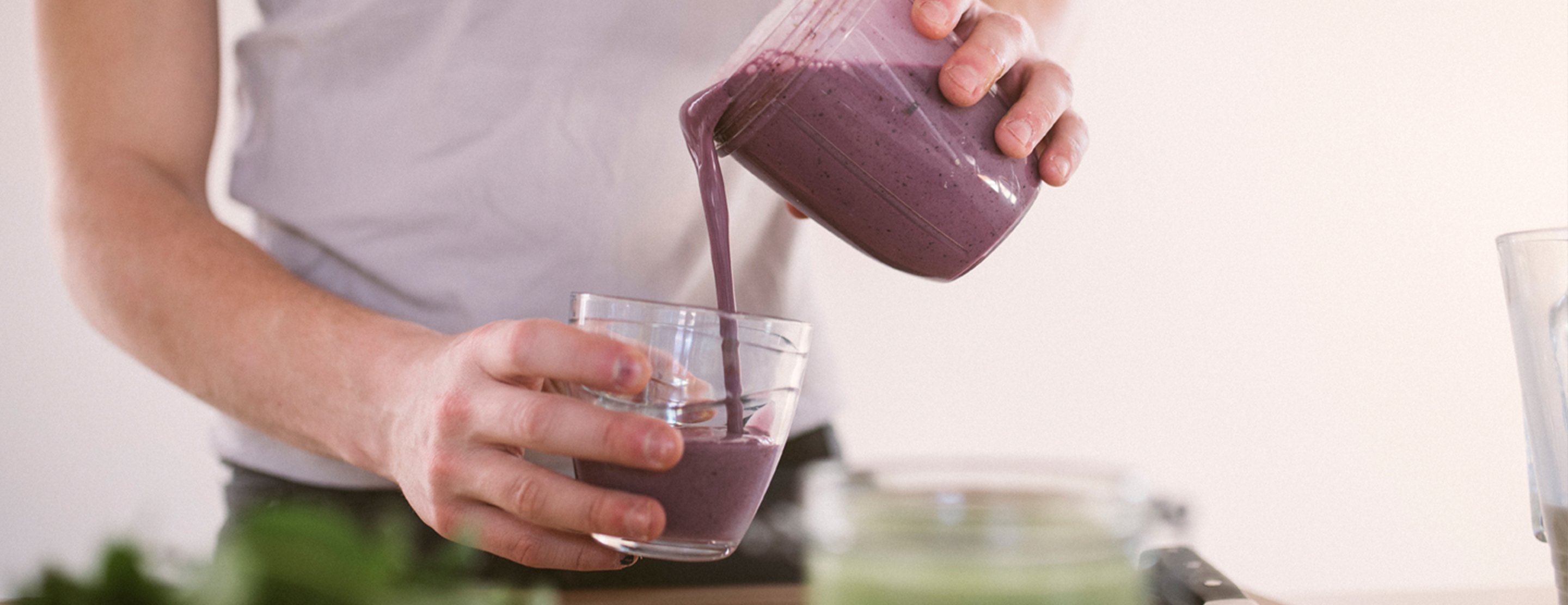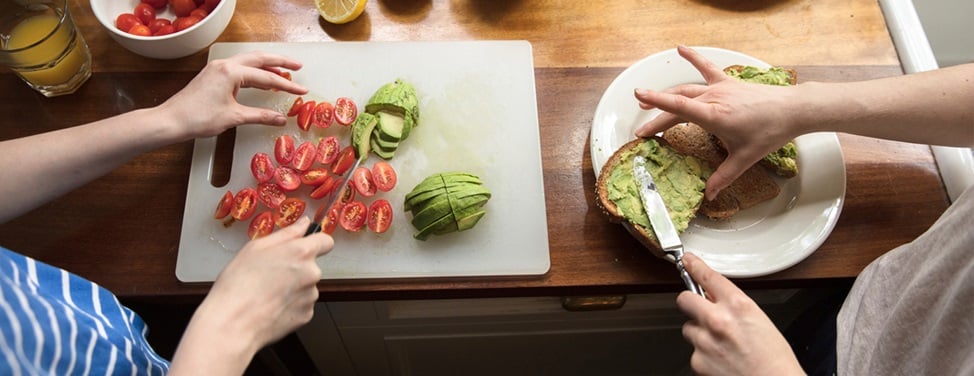
Nutrition Tips for Patients Receiving Head and Neck Radiation Therapy
Radiation therapy to the head and neck can cause side effects that make it difficult to take in adequate amounts of food and fluids. These side effects include loss of appetite, changes in taste or loss of taste, painful chewing and swallowing, mouth sores, dry mouth and nausea. The type and severity of side effects depend on the area treated.
Patients receiving treatments for head and neck cancer have increased nutritional needs. These increased needs, combined with treatment side effects, may lead to weight loss. It is important to try to maintain your weight while receiving radiation, even if you're overweight. Weight loss during cancer treatment is often more a result of muscle wasting than fat reduction. Loss of muscle tissue can result in:
- Reduced treatment effectiveness
- Less ability to tolerate treatment
- Increased severity of side effects
- Treatment disruptions
- Delayed healing
- Longer treatment recovery time
- Increased fatigue
- Feeding tube placement (in the case of severe muscle loss)
Handling side effects
During cancer treatment, nutritional goals focus on preventing weight loss, preserving muscle mass and supporting immune function. You can achieve these goals by getting adequate calories, protein, vitamins and minerals; changing how much or how often you eat; and staying physically active.
Early in radiation treatment, most patients are able to eat regular food. As long as you can tolerate doing so, eat foods with a variety of textures and consistencies to help maintain the strength of your swallowing muscles. If you start finding it hard to chew or swallow, you might transition to a soft or liquid diet.
Some foods can irritate a sore mouth and throat and thus may need to be avoided. These include citrus juice and fruits (such as oranges or grapefruit), pineapple and pineapple juice, tomatoes and tomato sauce, salsa, spicy foods, foods with rough textures (such as crusty breads or tortilla chips), coffee, soda, and berries with seeds. Alcohol is also potentially irritating and should be avoided during treatment and the healing period that follows.
There are several ways to deal with radiation's effect on taste. Maintaining good oral hygiene and rinsing your mouth with a solution of baking soda and salt water can help. Try sugar-free hard candies or gum between or right before meals to eliminate bad tastes. Tart or sour flavors may stimulate saliva production, which can help improve taste. If foods taste bland, try adding fresh herbs, mild spices, a pinch of salt or a few drops of maple syrup. If foods taste or smell unappealing, try eating them cold or at room temperature.
The course of radiation is short. When you have completed your treatment, you will gradually transition back to a regular diet that follows the protective and preventive guidelines for cancer survivors. If you have concerns or questions, speak with your dietitian or doctor.
Strategies for good nutrition during treatment
While dietary fat or added sugars are generally not restricted during treatment, there are many nutritious ways of increasing calories to prevent excess weight loss.
Eat small, frequent meals:
- Instead of three large meals a day, eat small amounts frequently throughout the day.
- Carry food with you at all times, so you can snack in the car, while waiting for treatment or to see your doctor, and at other opportunities.
Eat calorie-dense foods:
- Pick foods that pack a lot of nutrition into every bite, and include protein several times a day.
- Eat a variety of foods with many colors, textures and flavors. It's important to include fruits and vegetables in addition to high-calorie and high-protein foods.
Avoid plain food:
- Before you eat or drink anything, ask yourself, "What can I add to give this more calories or protein?" Make each bite count.
Concentrate on soft and liquid foods:
- Soft and liquid foods are easier and less time-consuming to eat. For example, stirring in one tablespoon of creamy almond or peanut butter into hot cereal an add 90 calories to your meal.
Use supplemental nutrition drinks:
- Liquid supplements can increase your calorie and protein intake. They require no preparation and are easy to carry with you. You can also make your own shakes at home.
Weigh yourself regularly:
- Keep a weight log. If your weight goes down, increase your calorie and protein intake. For accuracy, always use the same scale.
Have a good attitude:
- Be prepared for treatment side effects that make it hard to eat. Try following an eating schedule, making a meal plan in advance, or eating while watching an entertaining TV show.
Dietary recommendations
The best diet during head and neck radiation therapy is:
- High in calories
- High in protein
- Supportive of fluid needs
- Soft or liquid, when needed
Meal and snack ideas for a soft diet:
- Fresh or canned fruit with cottage cheese or yogurt
- Sliced banana and nut butter (natural peanut, almond or cashew butter) in yogurt
- Hot cereal (oatmeal, cream of rice or cream of wheat) cooked in milk or soy milk with nut butter added
- Super milk: powdered milk or protein powder added to milk or nondairy milk to drink and use in recipes
- Hard-boiled or deviled eggs
- Scrambled eggs cooked with oil or butter with added avocado and cheese
- Refried beans with melted cheese, sour cream and avocado
- Mashed potatoes made with liberal amounts of whole milk and butter or olive oil and topped with gravy
- Mashed sweet potatoes made with walnut oil or butter and honey
- Polenta made with butter and parmesan cheese
- Fresh or canned fruit with cashew cream (cashews blended with maple syrup and vanilla)
- Tuna or canned salmon with liberal amounts of mayonnaise or olive oil – alone or in a sandwich on soft bread
- Pureed vegetables – available in squeeze pouches in the baby food section of the grocery store
- Turkey pasta – cooked noodles, 1-2 Tbsp olive oil, cooked ground turkey, and parmesan cheese on top
- Noodles with Alfredo or pesto sauce
- Mild soups, such as chicken and rice soup, butternut squash or carrot soup, cream and potato-based soups
- Bean soups blended with olive or avocado oil
- Custard, flan or pudding made with whole milk
- Milkshakes or smoothies (buy or make)
- Jook (Asian rice porridge) with added egg or tofu, plus 1 Tbsp olive or avocado oil
- Glass of soy milk
- Mashed banana
- Applesauce
- Yogurt or kefir drinks
- Smoothies with soft fruit
- Yogurt with protein powder
Healthy ways to increase calories and protein
Here are some tips for boosting your calorie and protein intake. You can incorporate these into your diet before starting treatment or during the first few weeks. Some of these may not be appropriate for a soft or liquid diet or a sore mouth and throat. Soft and liquid diet suggestions are starred (*).
Add extra oil (such as olive, canola or avocado oil) to your food:
- Toss pasta with oil before adding sauce.*
- Drizzle oil into soup.*
- Add extra oil when cooking lean meats or vegetables (such as when stir-frying).
- Dip bread in olive oil.
- Drizzle olive oil onto freshly popped popcorn.
- Use oil-based dressings on salads, vegetables, pasta or other grains.
Boost calorie intake with nuts and seeds:
- Have a quarter to half a cup of nuts or trail mix as a snack.
- Carry nuts with you at all times; keep some at your desk or beside the couch.
- Sprinkle nuts and seeds into yogurt, cereal, oatmeal, salads, soups or stir-fries.
- Use nuts in muffin and bread recipes.
Add creamy nut butters – such as natural peanut, almond or cashew butter – to dishes:
- Dissolve nut butters in soups, hot cereals and smoothies.*
- Spread nut butters on sandwiches, fruit or crackers.
- Carry single-serving nut butter packets with you to snack on anytime.*
Increase calories with avocados:
- Add avocado chunks to soups.
- Blend avocado into smoothies.*
- Add avocado slices to a sandwich or salad.
- Add guacamole to Mexican food.
- Snack on half an avocado right out of the shell.*
More ideas:
- Eat fatty fish (such as salmon, halibut, sardines, herring and mackerel) two or three times per week.
- Snack on olives or add them to soups, salads or grains, such as pasta or rice.
- Snack on calorie-dense dips, such as olive spread (tapenade), hummus or pesto, or add them to potatoes, pasta or rice.
- Blend silken tofu into soups or smoothies.*
- Use milk (cow's, almond, soy or coconut) instead of water to make hot cereal.*
- Add powdered milk or unflavored protein powder to mashed potatoes, sweet potatoes or casseroles.*
- Add powdered milk or protein powder to a glass of milk or a smoothie.*
- Freeze supplement drinks, such as Kate Farms, into popsicles.
- Use a protein powder with minimal added sugars and other unnecessary ingredients. Whey protein isolate is made from cow's milk and is free of lactose, casein and fat. Plant-based protein powder options are usually made from pea, hemp, rice or soy.
Add-ons
These items can dramatically increase your overall calorie intake.
| Food | Calories |
| Butter (1 Tbsp) | 100 |
| Mayonnaise (1 Tbsp) | 100 |
| Oil (1 Tbsp) | 120 |
| Cream cheese (2 Tbsp) | 100 |
| Nut butter (1 Tbsp) | 100 |
| Avocado (one half) | 160 |
| Coconut milk (2 Tbsp) | 100 |
| Pesto sauce (2 Tbsp) | 100 |
| Salad dressing (2 Tbsp) | 170 |
| Cheese (1 oz) | ~100 |
| Powdered milk (2 Tbsp) | 80 |
| Protein powder (2 Tbsp) | 90 |
| Ricotta cheese (½ cup) | 215 |
| Whipping cream, heavy (1 Tbsp) | 52 |
| Chia seeds (1 Tbsp) | 60 |
Added sugars
If you're losing too much weight during treatment, added sugars can be a short-term way to get extra calories. To prevent spikes in blood sugar, add these high-sugar items to a meal instead of eating them by themselves.
| Maple syrup (2 Tbsp) | 100 |
| Honey (1 Tbsp) | 64 |
| Sugar (1 Tbsp) | 45 |
| Jelly (1 Tbsp) | 50 |
| Chocolate syrup (2 Tbsp) | 100 |
Liquid food examples
400+ calories
| Food | Calories | Protein (grams) |
| ENU Nutritional Shake (8.4 oz) | 400 | 20 |
| Kate Farms Standard 1.4cal/mL shake (11 oz) | 455 | 20 |
| Boost Very High Calorie Drink (8 oz) | 530 | 22 |
| Almond banana smoothie (see recipe section) | 550 | 35 |
| Sweet potato carrot smoothie (see recipe section) | 711 | 38 |
| Mango coconut smoothie (see recipe section) | 550 | 20 |
300-400 calories
| Food | Calories | Protein (grams) |
| Boost/Ensure Plus (8 oz) | 360 | 15 |
| Kate Farms Standard 1.0cal/mL shake (11 oz) | 325 | 16 |
| Benecalorie liquid calorie and protein additive (1.5 oz) | 330 | 7 |
200-300 calories
| Food | Calories | Protein (grams) |
| Cream of chicken soup (1 can) | 284 | variable |
| Cream of broccoli soup (1 cup) | 200 | variable |
| New England clam chowder (1 cup) | 200 | variable |
| Boost/Ensure regular (8 oz) | 250 | 10 |
| Orgain nutrition shake (11 oz) | 250 | 16 |
| Premium ice cream (½ cup) | 200 | 4 |
| Lentil and carrot stew (see recipe section) | 200 | 10 |
100-200 calories
| Food | Calories | Protein (grams) |
| Whole milk (1 cup/8oz) | 150 | 8 |
| Pudding or custard made with whole milk (½ cup) | 150 | 4 |
| Soy milk (1 cup/8 oz) | 80-120 | 8-12 |
| Yogurt (1 cup) | 100-250 | 8 |
| Coconut yogurt (½ cup) | ~200 | 2 |
| Cashew cream (½ cup, see recipe section) | 138 | 6 |
| Pear nectar (8 oz) | 120 | 0 |
Sample menu
Adjust portions up or down, based on your calorie and protein needs
Breakfast
1 cup cooked oatmeal or cream of wheat made with 8 oz milk or soy milk instead of water. Stir in ½ cup applesauce and 2 Tbsp natural creamy peanut butter.
Blend if a smoother texture is needed. (500 calories, 22 grams protein)
Snack
Mango coconut smoothie, ½ serving (see recipe section)
Refrigerate the second serving to have as an afternoon snack.
(275 calories, 10 grams protein)
Lunch
Salmon pasta toss
5 oz canned salmon or tuna (in oil, do not drain) (225 calories, 32 grams protein)
½ cup cauliflower, chopped and steamed soft (25 calories)
1 Tbsp mayonnaise or olive oil (100-120 calories)
1 cup cooked macaroni noodles (220 calories, 8 grams protein)
(590 calories, 38 grams protein)
Snack
Mango coconut smoothie, ½ serving (see recipe section)
(275 calories, 10 grams protein)
Dinner
Avocado chicken soup, 1 serving (see recipe section) (280 calories, 8 grams protein)
1 medium sweet potato, baked and mashed with 1 Tbsp olive oil or butter (320 calories, 3 grams protein)
(600 calories, 11 grams protein)
Snack
½ cup cottage cheese (100 calories, 14 grams protein)
½ cup canned peaches including juice (60 calories)
Blend if a smoother texture is needed.
(160 calories, 14 grams protein)
Sample menu totals
Calories: 2,450
Protein: 127 grams
Recipes
Almond banana smoothie
Ingredients:
1 cup soymilk
½ cup plain yogurt
4 Tbsp protein powder
1 Tbsp creamy almond butter
1 Tbsp oil, such as avocado or coconut oil
1 banana
Preparation:
Place all ingredients in blender, and blend until smooth.
Makes one 16-oz smoothie. (550 calories)
Mango coconut smoothie
Ingredients:
½ cup coconut milk (full fat)
½ cup mango nectar
½ cup mango chunks
¼ medium avocado
4 Tbsp protein powder
Preparation:
Place all ingredients in blender, and blend until smooth.
Makes one 12-oz smoothie. (550 calories)
Avocado chicken soup
Ingredients:
1 cup cream of chicken soup (homemade or store-bought)
1 cup chicken broth
1 ripe avocado, mashed
½ cup spinach, finely chopped
1 Tbsp olive oil
Preparation:
Mix cream of chicken soup with chicken broth or water in a saucepan. Add all other ingredients and heat until warm.
Makes 2 servings. (280 calories per serving)
Lentil and carrot stew
Ingredients:
6 oz dry lentils
3 cups water
4 medium carrots, peeled, quartered lengthwise and cut into 1-inch pieces (2½ cups)
1 onion, diced
1 small stalk celery, washed, trimmed and chopped (¼ cup)
3 bay leaves
1 tsp salt (optional)
1 bunch fresh cilantro or parsley, washed
1 Tbsp olive oil
Preparation:
Sort lentils, discarding any stones or damaged pieces. Wash in a sieve under cold water. Drain. Place in a large pot. Add water, carrots, onions, celery, bay leaves and salt. Remove cilantro or parsley leaves from stems and roots, and set leaves aside for garnish. Chop stems and roots; add to the pot. Bring mixture to a boil over high heat. Reduce heat to low, cover and cook at a gentle boil for 55 minutes. Let cool. Place in a blender, add olive oil, and process until smooth. Garnish with cilantro or parsley leaves when serving.
Makes 4 servings. (200 calories per serving)
Sweet potato carrot smoothie
https://cancer.ucsf.edu/recipe/2021/05/03/sweet-potato-and-carrot-smoothie
Cashew cream
https://cancer.ucsf.edu/recipe/2015/05/15/creamy-cashew-sauce-3-ways.6125
UCSF Health medical specialists have reviewed this information. It is for educational purposes only and is not intended to replace the advice of your doctor or other health care provider. We encourage you to discuss any questions or concerns you may have with your provider.









